Whole animals kingdom is divided into phyla. One of these phyla is phylum Arthropoda, animals belonging to this phylum are with jointed limbs. Insects belong to the class insecta of this phylum.
Insects are those animals (or arthropods) which posses three pairs of jointed limbs, example are flies, cockroaches, mosquitoes & beetles etc. Mostly insects are flying.
Vermin Control
Standard Operating Procedure is an essential and fundamental step. There are various species of vermin’s, which exist in the surrounding. They survive in nearly in every mode of climate whether it is hot, cold moderate humid etc. Mostly they crawl habituate but few of them contain wings for flying. These get easily access to everywhere. They can pass by even a tiny hole.
TheseVermin Control Standard Operating Procedure, especially insects not only hunt and feed their prey but also excrete their waste products during their stay over a certain area resulting contamination’s thus leading to messy pollution. Besides of these hazards the insects can grow and increase their population making the environment full of pollution. They are also carriers of microorganisms.
Purpose
To keep Production, Q.C., Warehouse & Admin areas cleaned and free from Vermin Control Standard Operating Procedure, insects, rodents etc.
Scope
This Vermin Control Standard Operating Procedure covers Production, Quality Control and warehouse departments
SOURCE OF VERMIN’S
Animals like:
Lizards, mice, rats, centipedes, millipedes and other unwanted animals should also be controlled.
Air brings various insects, these Vermin Control Standard Operating Procedure insects get in easily with a waving current of air, which provides an opportunity for the entrance of insects. Air can blow in through many places like doors, windows, walls, holes & ventilator holes in any where (walls, roof, ceiling, thresholds. Since metamorphosis developmental stages of insects like egg, larva, pupa, adult is somewhat consists of duration short insects population increases rapidly. These insects find an ideal atmosphere for their growth, development phases of insects require food components for energy and for their metabolism. These requirements are easily available in the surrounding atmosphere. Climate also favours their growth oftenly insects like i.e. big insects hunt/small insects to fulfill their survival hunt requirements. It also creates a big problem of pollution in the surrounding area.
As the insects are tiny creatures they do not require large area for their stay. They may live on shelves, floors, walls, ceiling etc. mostly the insects are photophilic in nature i.e. they like light and are much attracted by light waves.
Lizards may enter the department from exhaust and A/C ducts or through any space present in the department (under side of the doors).
Factory is located in such a place where snakes, rodents frogs and other unwanted dangerous animals may be present .the source of these animals is the area behind the factory. Here is thick vegetation and river Ravi. So more cares is to be taken. Drain holes are also a big source of cockroaches and other insects.
METHODS OF CONTROL OF VERMENTS
In Pharmaceutical insects may be controlled through proper applications of chemicals and by some specialized devices.
CHEMICALS:
- Insecticides
- Fumigants
- Repellants
- Attractants
- Killerat
DEVICES:
- Mechanical devices
- Lizard catchers
- Mouse trap
- Insectocuter
- Electric fly killer
INSECTICIDES:
Insecticides are often classified according to the type of action that results in destruction of the insects. Synthetic organic compounds possess insecticidal action in several ways.
Most of the insecticides in use today depend largely on contract action to destroy insects. Insecticidal chemicals are easily available in the market. These kill all the surviving insects rapidly. Houseflies, mosquitoes, wasps & all other bugs etc. can easily be killed by these chemicals. Routine spray of insecticidal solutions must be carried out. These chemicals not only eradicate insects, but also their offsprings do not survive. Moreover chances of entrance or presence of new insects and their growth are very low after regular usage/spray of these chemicals. Some common insecticials are typhone, phenyl, mortein, pifpaf, finis.
Regular use of phenyl solution (5%) and Dettol 2% (Chloroxylenol) are used for floor washing and mopping.
Floors of Q.C. are cleaned twice a day with phenyl 5% & Dettol 2%. The same procedure is adopted in production. The floors of warehouse are cleaned once a day.
The daily schedule of washing and mopping of floors is mentioned in SOP of General Cleaning Vermin Control Standard Operating Procedure
FUMIGANTS:
Fumigants are gases or vapors used to kill the insects, usually in enclosed spaces. One percent solution of Potassium permanganate in formalin is exposed once a week in production and once a month in warehouse and Q/C.
Procedure:
In a bowl take100ml formalin, add 1g KMnO4. Put this bowl in the area where fumigation is required. Such bowls are exposed in all the section of production, Q.C. and warehouse.
REPELLANTS:
A variety of insect control chemicals possess repellant action. Citronella and creosote are examples of such materials. These repellents could be used at the time of requirement. In routine they are not used.
ATTRACTANTS:
The use of attractants to capture or trap the insects has been employed as a means of control for many years. The attractants employed are usually favourite foods for the particular insect involved such as molasses, sugar, or milk for houseflies, sugar or grease for ants, bran for cutworms, bananas for cockroaches, decaying meats for blow flies and protein hydrolysate materials for tropical fruit flies such as Mediterranean fruitfully. In some cases specific chemicals prove highly attractive. Food materials are strictly prohibited in Q/C, production and warehouse but they are used to control insects under strict supervision. These attractants could be used at the time of requirement. In routine they are not used.
KILLERAT:
These are tablets, which are prepared from the poisonous chemical. When rates or other animals will eat them, they will die. Killerat are placed on the places from where rodents pass. These are used under strict supervision.
DEVICES:
MECHANICAL DEVICES:
Other than chemicals there are mechanical devices of value in fighting insect pests. The house screens, fly sweaters, insect proof packages for cereals may be included. Air curtains in production and warehouse also control the insect and microbe to enter the area.
LIZARD CATCHER
Lizard catcher is composed of a sticky material pasted on paper. When lizards pass over these catchers, they get attached to them and then sweeper will kill the lizard.
MOUSE TRAP:
Mousetrap is also a way to eradicate the rodents. These traps are put on the location, from where mouse passes some food material is attached with the trap. When mouse comes to eat the food and will pull the food material. It will get entrapped in the mousetrap and will be dead. These traps are used at the time of requirement.
INSECTOCUTOR:
Insectocutor are also present in the factory. They are used to kill insects. One insectocutor is present at the entrance of the packing hall, one in packing hall, one in liquid filling area, one liquid manufacturing area and one in main corridor of production area. One is present in the warehouse.
ELECTRIC FLY KILLER
These are used to kill flies, wast, moths etc. It is very excellent in performance. When the button of electric fly killer is pressed then electric current is present in the net of this fly killer. Now on touching the fly with this insect fly killer will kill the fly at the spot. Using this device insects are best controlled. These are provided to in production, warehouse & Q.C. deptt.
OTHER METHODS OF CONTROL:
Insects’ controls are divided into two parts.
Natural Control
Artificial Control
NATURAL CONTROL:
NATURAL ENEMIES:
Parasitic and predacious insects. Every insect is more or less hindered in its increases by other insects as well as by predacious birds, mammals and other animal life.
WEATHER AND TOPOGRAPHIC INFLUENCES:
Summer and winter temperatures, rainfall, soil and atmospheric humidity, and all similar natural factors have their effect on insects and their hosts.
ARTIFICIAL CONTROLS:
INSECTICIDES:
An insecticides may include any material used for the purpose of killing insects or of protecting crops, animals or other property against insect attack. Insect repellants, fumigants and attractants are considered insecticides in broad sense.
PARASITICIDES:
These substances kill animal parasites such as itch, mites, ticks, etc.
STERILIZING AGENTS:
The release of large numbers of insects treated by radioisotopes or chemicals to interfere with reproduction has produced high degrees of control of native populations with whom the sterilized individuals mate.
FILLING:
Hole in any portion of premises like walls, floors, ceilings, window etc these must be filled and leveled by cementing material like plaster of Paris, clay, concrete, lime etc. After filling the holes must be painted with at least two or three coatings.
SEALING:
Doors, windows, ventilators etc. must be sealed. By sealing action entrance of insects is avoided.
Usually plaster of Paris is used for sealing purpose by making its slurry in paint so that a viscous paste is established which is applied on the levels of spaces between door & floor, window & wall. After sealing performance insets have no passage for entry thus attempt of target for insect control is achieved.
A/C DUCT CONTROL:
Grills of A/C supply line and exhausts are provided with gausses so that lizard and other unwanted organisms can not enter the area. Drain holes are also provided with gausses.
After doing all this Q.C., Production, Warehouse & Admin areas are free of insects, lizard, snakes & other unwanted animals.
ANTS:
Several species of ants and pests may be present in the pharmaceutical industries or around the premises.
For ant control the best procedure in to locate the ant colony and apply Baygone, Dursban, Ficam.
COCKROACHES:
These may be found in homes and industrial establishments. Although the efficacy of different insecticides varies with the species.
Most aerosol formulas contain phyrethum, alletturin. Boric acid and boran in powdered form applied to hiding places and runways, are used for cockroach control. Although they are less effective and slower to produce results than most other insecticides. Baygone, Dursban and coopex sprays are widely used insecticides for cockroach control.
CONTROL OF RODENTS:
The following compounds are commonly employed to control rodents. They are dangerous are must be handled with caution.
BROMADIOLONE:
This is used as tracking powder for rodent control.
PHOSPHORUS:
It is used to kill the rats.
PROCEDURES OF CONTROL
STICKY TRAPS
These traps are used in our factory for catching insects, ants. Lizards and cockroaches.
TYPE 1
Description:
These are plastic sheets of size 20 x 5 cm covered with sticky material on one side. It can be loaded with Pheromone tablets, which attract the animals and bring it to the trap.
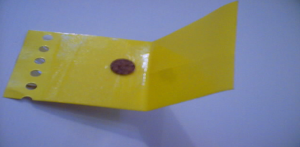
How/where to use and place it:
After removing the cover, Pheromone tablets (if available) has to be placed on the middle of the trap. Then the trap has to be placed at the defined area by either folding it in L or V shape. Now hang it with nail or tape with wall with sticky side exposed to room.
Frequency of monitoring:
These traps are checked once a week. Then animals are counted and results are taken in the record sheet.
Shelf life of the trap:
These traps could be used upto 10 weeks. After that the frequency of Pheromone tablets is decreased, then the tablet has to be removed or the whole trap is removed if it is not sticky.
Source:
The name of this trap is “Detia ESSIG- UND FRUCHT. FLIEGENFALLE”.
Available from Garda GmbH -D-65343 Eltville Germany
TYPE 2
Description:
These are made of paper, which is in triangular form, with sticky surface on the bottom of the triangle. These traps are used for catching cockroaches, lizards and ants.
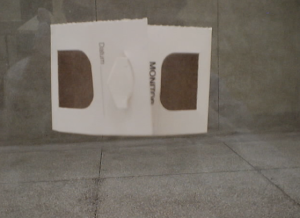
How/where to use and place it:
These traps can be loaded with Pheromone tablets. Trap is simply placed on flat surface like floor machine or cupboard.
Frequency of monitoring:
These traps are checked once a week. Then animals are removed, counted and results are taken in the record sheet.
Shelf life:
These traps could be used upto 12 weeks. After that the frequency of Pheromone tablets is decreased, then the tablet has to be removed or the whole trap is removed if it is not sticky.
Source:
The names of these traps are Supper cockroach glue traps ,Monitor schabenklebefalle and Insect trap and monitor. It is available from FMC United (pvt) ltd. Lahore Pakistan.
Ph: 75100956
ELECTRIC FLY KILLER
TYPE 1-Electric Fly Killer
Description:
It is racket-shaped device having a middle net. It is two feet long .It is made of plastic material.
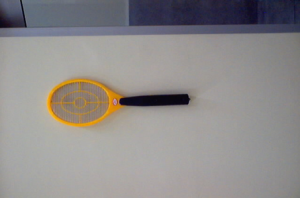
How/Where to use and place it:
It is used like traditional house fly killer, but with the possibility of making electric field by pushing the button. The activity of electric field is indicated by red light. They are used as an emergency tool whenever it is needed.
Frequency of monitoring:
Whenever insect is killed, it is recorded in the record sheet.
Shelf life:
When its battery is expire, it is replaced by new one.
Source:
It is available from Al-Akas Liberty Market Lahore.
TYPE 2-Insectocutor
Description:
These are circle- shaped electric tubes enclosed in boxes. The size of box is 70x30x30 cm.
The diameter of electric tube is one inch.
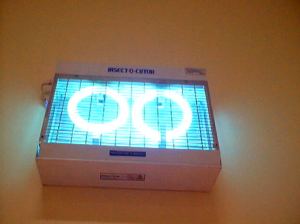
How/Where to use and place it:
These insectocutors are hanging with the ceilings at a height of about four meters. These are connected with electric supply line.
Frequency of monitoring:
These insectocutors are checked on weekly basis. Killed insects are counted and are results are recorded in the record sheet.
Shelf-life:
These are permanently hanging in the factory. There is no special limitation for it. Whenever they are out of order they are replaced or repaired.
Source:
It is available from Sole distributors Kiran international ltd. 1003-1005 uniplasa I.I chandrigarh Road Karachi.
MECHENICAL TRAPS TYPE 1-Mouse Traps
Description:
It kills the animals by breaking its neck with iron rod. Its size is 15×4 cm. It is totally iron-made.
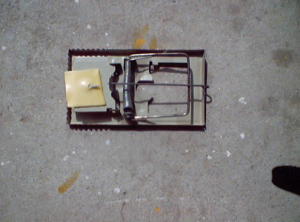
How /Where to use and place it:
It is loaded with a piece of cheese, then it is paced on the floor. It is exposed in a corner or at a place where it is not disturbed by any one.
Frequency of monitoring:
Traps are checked at daily basis .If animal is trapped, it is removed. Then trap is washed, again it is loaded and exposed. Results are recorded in the record sheet.
Shelf-life:
There is no special limitation for the shelf life. If it becomes out of order, then it is replaced.
Source:
It is a simple iron-made mousetrap. It is available from super store 30 K.M. Multan Road , Sunder Stop Lahore
POISON MATERIALS
These are different types of materials containing poison materials.
TYPE 1-Killerat
Description:
These are cubes of size 3x3x1cm.It contains 0.005 mg Tetragonal (P2ZN3). Their colour is dark blue. They are packed in paper and plastic material.
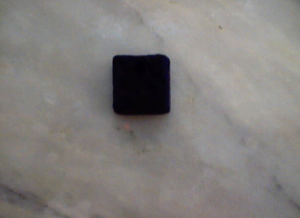
How /Where to use and place it:
The packs have to be opened with gloves (don’t touch by fingers). They are placed on the floor near to corner or wall or any suitable place.
Frequency of monitoring:
They are checked on daily basis whether eaten traces are there or not. Results (either a little or bigger trace)
Have to be recorded in record sheet. The area around poison cube has to be searched for mouse or rat after four days.
Shelf-life:
We define the shelf life as one year if cubes are untouched after one year. .
Source:
It is available from Public Health Pakistan Plot 150,17th st. phase 1, Industrial area DHA Karachi.
Tel: 5888021 Fax: 5888021.
TYPE 2-Powder
Description:
It is powder material used to kill ants. Its name is Tyfon Super Active Powder. Its active ingredient is 0.5% Permethrin.
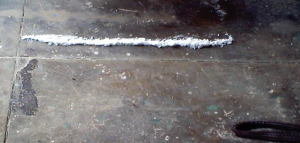
How /Where to use and place it:
Place some powder material near in the corners or at replace where it is not disturbed.
Frequency of monitoring:
Check the area on weekly basis by searching the animals (ant) nearby.
Shelf-life:
Replace the powder material after 1 month.
Source:
It is purchased from the local market. It is available from Super Store 30 K.M. Multan Road, Sunder Lahore.
LABELLING OF CHECK POINTS:
A laminated label is pasted at all the check points on the wall near to the material. This sheet contains the name of place, date of placement, and signature of the inspector. When the label has to be changed then a new label with new date of placement is pasted there.
LABEL#1
- Vermint Check Point
- No.: ST1
- Placement date: ________
- Sign.________
Abbr: – ST for sticky trap
– EC for electrical club
– IC for Insectocutor
– MT for mouse trap
– PMC for cubes against mice
– PMT for tins against mice
– PMS for against silver fish
– PMP for powder against aunt
Abbr. +running numbers, e.g. ST 1
VISUAL CONTROL OF THE AREA:
In addition to the above mentioned activities a visual control of the production area as well as the warehouse has to be done frequently. It has to be checked whether any traces of animal like spiral web, stooling of mice feathers, hair, foot prints or any thing else has been found. This should be done on weekly basis also and a result has to be recorded in the protocol.
VERMIN ALL CHECK POINTS:
All check points have to be chosen according to the purpose. The check points have to be marked with above mentioned label and have to be indicated in the layout plan of the factory. They have to be chosen in such a way not to disturb routine work or not destroyed by any one .On the other hand they have to be placed at critical points where appearance of vermints is to be expected. Critical in general are any cracks or openings as well as humid or wet places. Also hidden or shelter places are attractive for all kinds of vermints. So according to the need the now fixed check points might be shifted later on according to our experience. In any case the activities to monitor or fight the vermints must not endanger our products. That means neither poisons or other substances which attract the vermints have to be placed nearer to raw material or equipment which is ready for use.
MEASURE
When ever animals or traces of animals have been observed a protocol for measure (beside the monitoring protocol) have to be filled out by Q.A. Manager. In which it is instructed which action have to be taken in this case.
The routine monitoring tests are recorded in the protocol, which is attached here as attachment. All other observation which are done beside the vermint check points have to be protocol and protocol sheet.









